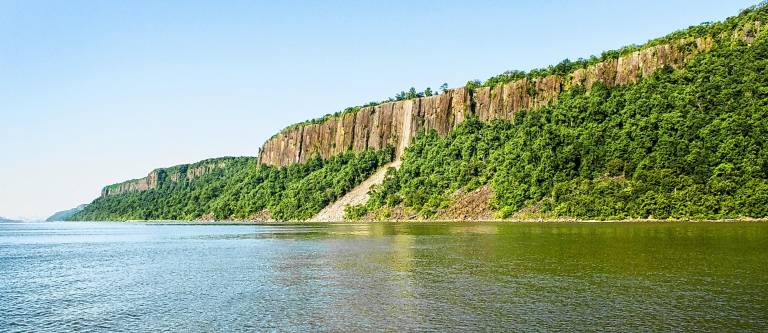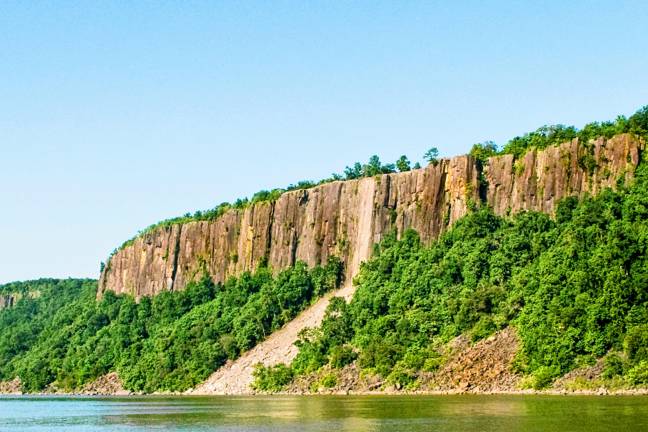The State We’re In: Saving the Palisades


This year, we celebrate the 125th anniversary of the Palisades Interstate Park Commission, a pioneering model of environmental preservation.
Long before conservation was a part of public consciousness, a group of determined citizens banded together to stop the destruction of the Palisades cliffs along the Hudson River.
Their efforts saved an iconic landscape and laid the groundwork for the modern parks movement.
It began at the turn of the 20th century, when dynamite blasts echoed across the Lower Hudson. Quarry operators were carving away the Palisades to feed New York City’s building boom.
A coalition of citizens and extraordinary visionaries came to the rescue of the scenic cliffs. While New Yorkers sounded the alarm, it was really the New Jersey State Federation of Women’s Clubs that turned the tide of destruction with their lobbying efforts in Trenton.
Their advocacy caught the attention of New Jersey Gov. Foster Voorhees, who joined with New York Gov. Theodore Roosevelt to create the Palisades Interstate Park Commission in 1900.
At the time, neither New York nor New Jersey had a state park system. Several national parks had been established in the west, including Yellowstone and Yosemite, but the National Park Service wouldn’t be founded until 1916 and there was no overarching system.
So, the new commission enlisted wealthy philanthropists, who helped buy out the quarry companies and create the Palisades Interstate Park. It was a novel solution at a time when public money for land conservation was unheard of.
The founding of the Palisades Commission, one of the earliest and most innovative public-private partnerships in American environmental history, saved an incredible landscape, and pioneered a model of civic vision, cross-state cooperation and long-term stewardship.
About the time of the creation of the park, the public health movement was beginning to link fresh air and nature with well-being, spurring a greater interest in access to parks.
There was a growing recognition of the need for a place for New Yorkers to recreate outside of the increasingly polluted city center. The Palisades became that place.
Thanks to ferries and trains, working families could escape the city for a day of fresh air and green space.
“It wasn’t just the elite going to their country homes,” says Joshua Laird, the commission’s executive director. “It was about democratizing nature.”
In many ways, the preservation of the Palisades laid the groundwork for the creation of a national parks system that would preserve the country’s natural wonders for generations.
Roosevelt was deeply influenced by the success of the commission, and as president, he expanded America’s national parks and monuments, and established the National Park Service.
Today, the lands operated by the commission span nearly 130,000 acres and include 30 parks and historic sites from Fort Lee, N.J., to Bear Mountain, N.Y., and beyond.
The cliffs are designated as a National Natural Landmark and the Palisades Interstate Park is a National Historic Landmark. The entire system hosts more than 9 million visitors a year, aided by the Palisades Parks Conservancy, a nonprofit that partners with the commission.
Threats are ever-present. A proposal for a high-rise building for LG’s new North American headquarters would have marred the unbroken viewshed north of the George Washington Bridge. Outcry, negotiations, legal action and appeals from four former New Jersey governors ensued, and conservation efforts again prevailed in protecting the integrity of the cliffs in 2017.
The parties reached a settlement for a lower design for the building - celebrated as a “win-win” solution.
As Laird reflects on the anniversary, he says: “We’ve inherited a legacy that is more than just land preservation; it’s a living example of what’s possible when communities, government, and individuals come together to protect something greater than themselves. The Palisades is a testament to what can happen when we put our values of stewardship and connection to nature into practice.”
The Palisades Interstate Park Commission is more than a successful, historic 125-year-old institution. It’s living proof that bold conservation ideas, sustained by public commitment, can endure and flourish across centuries.
For information about these important organizations, go online to njpalisades.org/index.html and New Jersey State Federation of Women’s Clubs at njsfwc.org
To learn about how you can help preserve New Jersey’s natural resources, visit the New Jersey Conservation Foundation at njconservation.org or send email to info@njconservation.org
Alison Mitchell is executive director of the New Jersey Conservation Foundation.